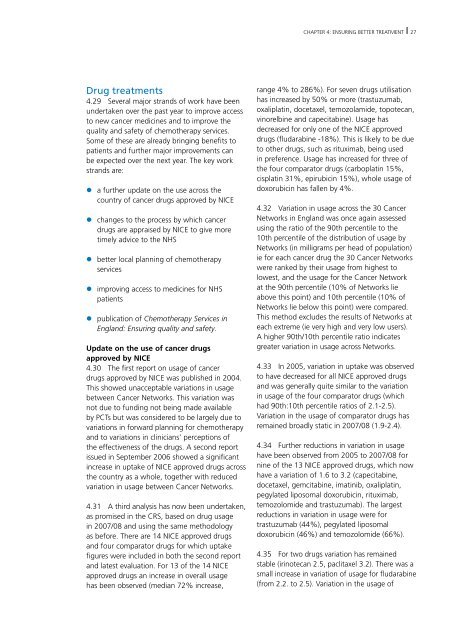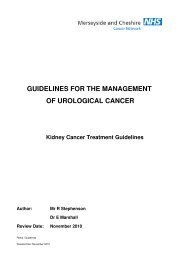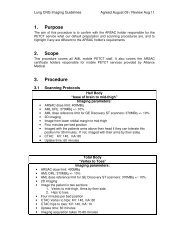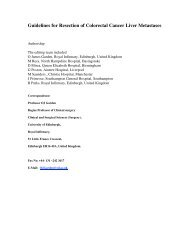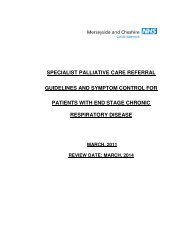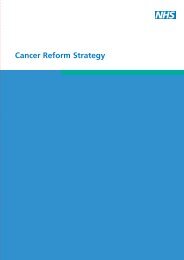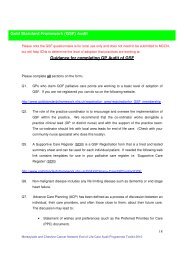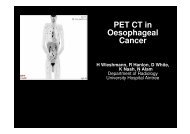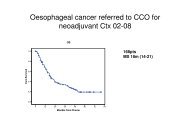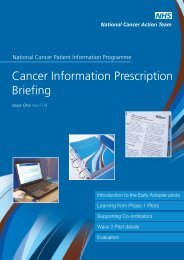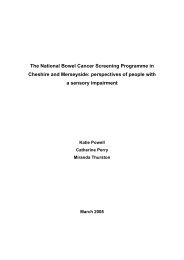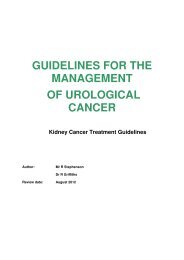Cancer Reform Strategy - First Annual Report - Merseyside ...
Cancer Reform Strategy - First Annual Report - Merseyside ...
Cancer Reform Strategy - First Annual Report - Merseyside ...
You also want an ePaper? Increase the reach of your titles
YUMPU automatically turns print PDFs into web optimized ePapers that Google loves.
CHAPTER 4: ENSURINg BETTER TREATMENT27Drug treatments4.29 Several major strands of work have beenundertaken over the past year to improve accessto new cancer medicines and to improve thequality and safety of chemotherapy services.Some of these are already bringing benefits topatients and further major improvements canbe expected over the next year. The key workstrands are:• a further update on the use across thecountry of cancer drugs approved by NICE• changes to the process by which cancerdrugs are appraised by NICE to give moretimely advice to the NHS• better local planning of chemotherapyservices• improving access to medicines for NHSpatients• publication of Chemotherapy Services inEngland: Ensuring quality and safety.Update on the use of cancer drugsapproved by NICE4.30 The first report on usage of cancerdrugs approved by NICE was published in 2004.This showed unacceptable variations in usagebetween <strong>Cancer</strong> Networks. This variation wasnot due to funding not being made availableby PCTs but was considered to be largely due tovariations in forward planning for chemotherapyand to variations in clinicians’ perceptions ofthe effectiveness of the drugs. A second reportissued in September 2006 showed a significantincrease in uptake of NICE approved drugs acrossthe country as a whole, together with reducedvariation in usage between <strong>Cancer</strong> Networks.4.31 A third analysis has now been undertaken,as promised in the CRS, based on drug usagein 2007/08 and using the same methodologyas before. There are 14 NICE approved drugsand four comparator drugs for which uptakefigures were included in both the second reportand latest evaluation. For 13 of the 14 NICEapproved drugs an increase in overall usagehas been observed (median 72% increase,range 4% to 286%). For seven drugs utilisationhas increased by 50% or more (trastuzumab,oxaliplatin, docetaxel, temozolamide, topotecan,vinorelbine and capecitabine). Usage hasdecreased for only one of the NICE approveddrugs (fludarabine -18%). This is likely to be dueto other drugs, such as rituximab, being usedin preference. Usage has increased for three ofthe four comparator drugs (carboplatin 15%,cisplatin 31%, epirubicin 15%), whole usage ofdoxorubicin has fallen by 4%.4.32 Variation in usage across the 30 <strong>Cancer</strong>Networks in England was once again assessedusing the ratio of the 90th percentile to the10th percentile of the distribution of usage byNetworks (in milligrams per head of population)ie for each cancer drug the 30 <strong>Cancer</strong> Networkswere ranked by their usage from highest tolowest, and the usage for the <strong>Cancer</strong> Networkat the 90th percentile (10% of Networks lieabove this point) and 10th percentile (10% ofNetworks lie below this point) were compared.This method excludes the results of Networks ateach extreme (ie very high and very low users).A higher 90th/10th percentile ratio indicatesgreater variation in usage across Networks.4.33 In 2005, variation in uptake was observedto have decreased for all NICE approved drugsand was generally quite similar to the variationin usage of the four comparator drugs (whichhad 90th:10th percentile ratios of 2.1-2.5).Variation in the usage of comparator drugs hasremained broadly static in 2007/08 (1.9-2.4).4.34 Further reductions in variation in usagehave been observed from 2005 to 2007/08 fornine of the 13 NICE approved drugs, which nowhave a variation of 1.6 to 3.2 (capecitabine,docetaxel, gemcitabine, imatinib, oxaliplatin,pegylated liposomal doxorubicin, rituximab,temozolomide and trastuzumab). The largestreductions in variation in usage were fortrastuzumab (44%), pegylated liposomaldoxorubicin (46%) and temozolomide (66%).4.35 For two drugs variation has remainedstable (irinotecan 2.5, paclitaxel 3.2). There was asmall increase in variation of usage for fludarabine(from 2.2. to 2.5). Variation in the usage of


